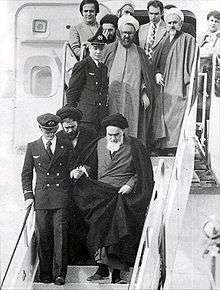Ruhollah Khomeini's return to Iran
Part of a series on the |
|---|
| History of the Iranian Revolution |
 |
|
Revolutionary leaders
|
|
Official institutions |
|
See also |

On 1 February 1979 Ayatollah Ruhollah Khomeini, returned to Iran after 14 years in political exile. Khomeini had been a prominent opponent of Mohammad Reza Shah Pahlavi, who had fled the country during the events of the Iranian Revolution. Upon his return, he was greeted by crowds of millions, and within 10 days the revolution would be successful. Khomeini's return and the 10 days following are now celebrated in Iran as the Fajr decade.
Preparing for travel
Khomeini decided to return to Iran after Mohammad Reza Pahlavi, the Shah of Iran, fled on 16 January 1979. A welcoming committee was formed on 21 January 1979, to organise and ensure Khomeini's return.[1]
It was originally planned that Ayatollah Khomeini would enter Iran on January 26, but Prime Minister Shapour Bakhtiar announced that the airports would be closed. From Paris Khomeini declared that he would return as soon as the airports were reopened. The closure of the airports led to widespread protests and strikes. In Tehran alone 28 people were killed. On January 29, the airport was reopened on the orders of Bakhtiar and Khomeini stated a new return date of 1 February.[2]
The flight

On 1 February Khomeini flew to Iran in a chartered Air France plane. He was accompanied by supporters as well as 120 international journalists. The presence of journalists was in part to ensure the safety of the plane from being attacked.[3][4]
Journalist John Simpson, asked Ayatollah Khomeini how he felt about returning to Iran after fifteen years. Khomeini famously answered: "Hichi" (Nothing).[5] Khomeini's statement attracted much attention, and its meaning has been heavily disputed. [6] Some amongst Khomeini's critics have claimed his response demonstrated apathy towards Iran and its people. Others have interpreted his response as inspired by Ibn Arabi's philosophy of the Perfect Man, and Shia mysticism, arguing that Khomeini was attempting to reach a perfect emotionless state, like that of the Mahdi.[7]
Arrival and visit to Behesht-e Zahra
At 9:27 am on February 1st 1979 Khomeini arrived in Iran and received a welcome from millions of Iranians. This event is celebrated as a public holiday in Iran. After delivering a speech at the Mehrabad International Airport, he traveled to the Behesht-e Zahra cemetery, where many people who were killed during the revolution were buried. Millions of supporters lined on the path cheering his name, and hundreds of thousands gathered at the cemetery to listen his speech.[8] Khomeini declared that Shapour Bakhtiar's cabinet was illegal and he said he would strike the face of the government.[9][10]
Government collapse
On February 5th Ayatollah Khomeini choose Mehdi Bazargan as prime minister of interim government.[9]
On February 8th Iranian air force officers went to Khomeini's home and promised their loyalty to the revolution.[11] Two days later people were armed by the revolutionary personnel of the air force. Bakhtiar's government announced a curfew that Ruhollah Khomeini urged people to disregard. Revolutionaries subjugated police stations, prisons and governmental centers.[12] On February 11th Senior military commanders announced that they were neutral in conflict between Bakhtiar's government and revolutionaries. Thus they receded from the streets.[11] Bakhtiar resigned and went to Paris. Revolutionaries gained a victory in this day.[13] The ten days between Khomeini's arrival and revolutionary victory are celebrated in Iran as the Fajr decade.
See also
References
- ↑ "Oral History of the welcoming committee of Imam Khomeini". Retrieved 14 May 2015.
- ↑ Abrahamian, Ervand (1982). Iran between two revolutions. Princeton, N.J.: Princeton University Press. ISBN 069100790X.
- ↑ My century BBC
- ↑ Jerome, Carole (1 September 1980). "Back to the Veil". New Internationalist (091). Retrieved 3 August 2013.
- ↑ "12 Bahman: Khomeini Returns". PBS. 1 February 2009. Retrieved 4 August 2013.
- ↑ Unpaved Road: An Iranian Girl's Real Life Story of Struggle, Deception and ... By Niki Bahara]
- ↑ Axworthy, Michael (2007). Iran : empire of the mind : a history from Zoroaster to the present day. London: Penguin. pp. 265–6. ISBN 014103629X.
- ↑ "On This Day: Ayatollah Khomeini Returns From Exile". 2011. Retrieved 14 May 2015.
- 1 2 Iran Country Study Guide Volume 1 Strategic Information and Developments. Lulu.com. 2012. p. 65. ISBN 9781438774626.
- ↑ Heather Lehr Wagner (2010). The Iranian Revolution. Infobase Publishing. p. 13. ISBN 978-1-4381-3236-5.
- 1 2 Int'l Business Publications (2005). Iran: Country Study Guide. p. 124.
- ↑ Hosseini, Mir Masood. "Bakhtiar Becomes Prime Minister". fouman.
- ↑ "1979: Victory for Khomeini as army steps aside". bbc.